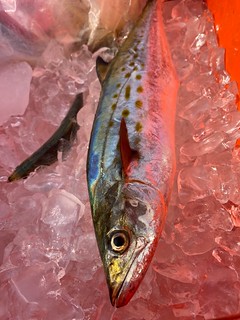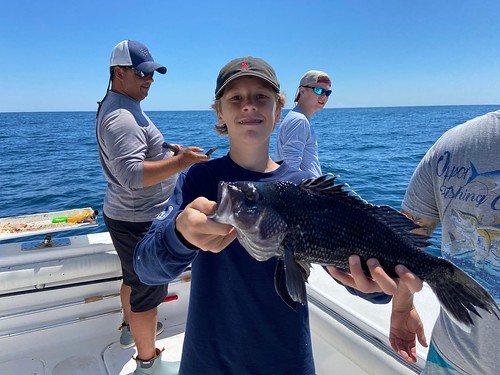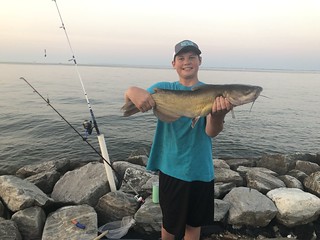Maryland Fishing Report – July 28
The striped bass fishery will reopen Sunday, August 1. During the closure, anglers are targeting alternate species such as catfish, perch, spotted sea trout, red drum, bluefish, cobia, and Spanish mackerel. Sea bass have been a reliable target fish for ocean anglers with the warm weather and calm seas.
Throughout the summer, be sure to check the striped bass fishing advisory forecast to help protect this iconic species during harsh conditions.

Forecast Summary: July 28 – August 3:
Sunny, very warm weather all this week should continue to keep Bay water temperatures high. Long-term Maryland DNR water monitoring shows peak Bay temperatures typically occur in mid to late July. Bay surface water, river, and steam temperatures are in the mid 80s and will continue to rise this week. July monitoring data is showing main Bay bottom waters are still slightly cooler than surface waters, and continue to show poor oxygen conditions. As a result, Bay gamefish will likely be higher in the water column to find adequate oxygen and their preferred water temperatures. The coolest oxygenated bottom waters can be found from the Kent Island area north to Tolchester. Due to evening Conowingo Dam releases, cool water is also present on the Susquehanna River through the Susquehanna Flats area in the late evening and early morning. Bay surface temperatures cool by 2 to 3 degrees at night.
Due to low bottom oxygen levels, avoid fishing below the following depths in these locations: Swan Point, 25 feet, Bay Bridge to Bloody Point, 5 feet to 25 feet; Choptank River to Point No Point, 15 feet to 35 feet. On the Potomac River from Colonial Beach to Piney Point, avoid fishing deeper than 5 feet to 35 feet. Conditions can vary daily so be sure to check the depth-to-oxygen level online prior to your next fishing trip.
Maryland upper bay waters down to the Bay Bridge are running saltier than normal while the bay waters below the bay bridge are normal. Expect average flows for most Maryland rivers and streams. There will be average tidal currents all week as a result of the July 25 full moon. Expect average clarity for Maryland portions of the Bay and rivers, with very poor water clarity due to algal blooms in the Northeast, upper Bush, Back, and middle Patuxent rivers. Reduced water clarity from localized high flows may be present in some areas from possible thunderstorms on Wednesday and Thursday. To see the latest water clarity conditions, check Eyes on the Bay Satellite Maps.
For more detailed and up-to-date fishing conditions in your area of the Bay, check the Maryland DNR website for Click Before You Cast. Get regular updates on Maryland’s waters sent to your inbox with our Eyes on the Bay newsletter. Sign up online.

The tidal rivers north of Baltimore have been a hot spot for snakehead anglers. Angler Brady Lovalvo, age 11, caught a 32.5-inch Northern snakehead in Galloway Creek on July 24. Photo by Tara Lovalvo
During the summer, the Conowingo Dam releases large amounts of water during the afternoon hours for power generation, and shuts down during the early morning hours. Recent flows have been relatively high, in the range of 60,000 cubic feet per second, and the dam crews are preparing for spill conditions with one to five gates expected to be open during the next few days. For more information on spill conditions, please call the Conowingo spill hotline at 1-877-457-2525. Blue and flathead catfish have been common in the dam tailrace area.
Blue catfish and channel catfish in the upper Bay should provide steady action through the striped bass closure. Anchoring up or drifting with cut baits are good ways to fish for them, as is casting from shore. Fresh-cut menhaden or gizzard shad make the best baits, but frozen menhaden, sea herring, chicken liver, nightcrawlers ,and clam snouts can work well on a simple one-hook bottom rig. Using a fish finder rig can work well for finicky catfish since they do not feel the weight of the sinker when picking up the bait. Fishing for white perch can offer plenty of fun for those fishing light tackle in the tidal rivers and creeks of the upper Bay. Small lures such as beetle spins, spinners, small jigs, and twister tails are good choices to fish shoreline structure in the early morning and late evening hours. White perch have also moved out into the Bay and are holding on oyster knolls and shoals. Fishing with a bottom rig baited with pieces of bloodworm, grass shrimp, or Fishbites is productive. Use the lightest possible sinker to hold bottom. Around 1 ounce works well enough if currents are slow.
White perch will be offering light-tackle action for anglers during and after the striped bass closure. The perch are available in the tidal rivers and creeks and casting small lures in the early morning and evening hours. Shoreline structure such as submerged rocks, rip-rap, old breakwaters, and points are all good areas to cast beetle spins, small spinners, and jigs. Many deeper shoreline areas near piers can offer fun white perch fishing by using simple bottom rigs baited with grass shrimp or pieces of bloodworm. Small jig heads tipped with grass shrimp or bloodworm work well also and perch will be found holding close to dock piers and pilings and under the docks.
Channel catfish, along with a few blue catfish, continue to provide steady action on cut fish baits and chicken livers.
Spotted sea trout — also known as speckled trout — are being found around the mouth of the Choptank River and as far north as Eastern Bay. Paddletails on 1/8-ounce to 3/16-ounce jig heads are a popular lure, and they can also be caught on soft crab or peeler crab. Anglers have been reporting that some of the sea trout have moved out to slightly deeper water off the shoreline during the recent heat wave.

Marty Zupancic caught a limit of Spanish mackerel up to 20 inches around Point Lookout and Cornfield Harbor, trolling with a #2 planer and size 0 Drone and Clark spoons and casting metal spoons on light tackle. Photo by Marty Zupancic
Cobia are still being reported in the lower bay. Chumming and drifting live eels back in the chum slick is a proven method to catch one of these great gamefish. Be prepared to see a lot of cownose rays hitting baits while chumming. Trolling surgical tubes or hoses is also productive. Sight fishing with an elevated platform has become an increasingly popular fishing method in recent years. After spotting a cobia, casting a live eel, large soft plastic, or large bucktail is a good way to target them. Smith Point, the Middle Grounds, the Target Ship, and Virginia waters are good places to find cobia.
There are puppy drum in the shallows up to the South River and the Choptank mouth. Small paddletails work great for these fish. The larger bull redfish are beginning to show up in southern Maryland waters.
Numbers of Spanish mackerel are increasing in the lower Bay and they should continue to move north with the warm, dry weather in August. Trolling small Drone and Clark spoons behind inline weights and planers at a speed of 6-8 knots is the best method. Casting and retrieving small metal lures at high speeds around breaking Spanish mackerel is another effective technique.
Bluefish are working their way up the Bay and have been found around Cedar Point, up to Breezy Point and the mouth of the Choptank River.
The Cedar Point rocks, bulkhead areas, the cuts through Hoopers Island, and the Marsh edges of the lower Eastern Shore are all good places to fish for spotted sea trout. Another good spot for casting in recent years is around the foundation structure of Sharp’s Island lighthouse. Some speckled trout have been found as far north as Eastern Bay.
Bottom fishing in the lower Patuxent River, Solomons Island, Tangier Sound, and St. Mary’s River should be steady into the first few weeks of August. Some flounder are being caught in the Tangier and Pocomoke sounds along channel edges and adjacent hard shoals, and around Point Lookout and Cornfield Harbor. Croaker have been rare with only a few small ones reported, mainly in Virginia waters.
A reminder that the main stem of the Potomac River will remain closed to striped bass fishing through August 20. The tidal rivers on the Maryland side of the river will stay closed until August 1.
Recreational crabbing has been tough for most crabbers this year, with some large ones up to 9 inches being caught in the upper Bay. There has been some success reported in the Severn River and Annapolis areas. Recreational crabbers can catch anywhere from a couple dozen good crabs up to a half bushel or more with trotline gear. Generally, catch in the lower Bay has been lagging behind the middle and upper Bay regions with some decent action between Deale and the West and Rhode rivers last week. In recent years, most savvy crabbers find using razor clams will produce better catches, while others rely on the old standby, chicken necks.
Our inland fisheries biologist and resident muskie expert Josh Henesey reports that the upper Potomac River continues to run low and clear. Anglers are still experiencing excellent fishing throughout the river for smallmouth bass; particularly in the morning and evening hours. As flows continue to drop, smallmouth bass become more concentrated in the slightly deeper pockets of water.
A nuisance algae species has returned with a vengeance since reporting last week. It is suspected that the milder weather last week lowered water temperatures back into the optimal growing range reported for this species.
Freshwater biologists have been conducting the annual seining survey for smallmouth bass juvenile recruitment. Preliminary observations suggested an excellent hatch; however the survey thus far has indicated below-average numbers. There appears to be some fish health issues that are impacting juvenile smallmouth in particular — staff are currently collecting samples of these fish to identify the cause. A detailed summary will be available following the conclusion of this survey.
As we reported last week, both channel and flathead catfish species are found in high abundances and have been providing recreational opportunities throughout the river. These species tend to seek out deeper water during daylight hours with abundant woody debris. At night, which is the most common time for angling, larger fish move into the shallows to feed. Channel catfish can be caught on a variety of dead baits, including chicken liver and cut fish, while flatheads tend to be more selective and finicky, and prefer live baits.
Invasive snakehead continue to strike plastic frogs, spinners, buzzbaits, paddletails, and chatterbaits in the usual locations including the tidal rivers north of Baltimore and the Blackwater area on the Eastern Shore.

Angler Tracy Dunaway with an impressive 41.5-inch fork length mahi-mahi which is a nice catch for an inshore party boat. Photo by Monty Hawkins
Recent reports from the Atlantic coast indicated continued improvement of water clarity in the surf. Anglers are catching kingfish, small croaker, and spot on pieces of bloodworm or Fishbites. Those fishing with cut spot strips are catching small bluefish and flounder. There was also a showing of large red drum in the surf.
At the inlet and back bays, there have been decent numbers of mainly sub-legal striped bass. Most are working white soft plastic jigs or bucktails dressed with a curly tail, and the “Roy Rig” lure near the South Jetty and near the Route 50 Bridge. Small and medium-sized bluefish are running in and out of the inlet and back bay areas.
In the back bay areas, the summer fishing focus continues to be on flounder and they are being found in the usual channel areas of Assawoman and Sinepuxent bays, the “Thoroughfare” near the Route 50 Bridge, and the backside of Assateague Island near the Verrazano Bridge. Drifting with traditional baits of squid strips or minnows is popular, and working large soft plastic jigs and Gulp baits in white or pink work well for the larger flounder.
The wreck and artificial reef sites continue to provide excellent fishing for black sea bass. Flounder have also been caught around the artificial reef and wreck sites around the edges of the structure. Mahi-Mahi — known as dolphinfish — have also showed up inshore, creating some excitement for party boat anglers.
Most of the offshore action has been with yellowfin tuna and deep dropping with dead baits for swordfish. Reports indicated success with trolling for yellowfin tuna at the Washington canyon, but it has slowed down in recent days. Anglers also reported that several hooked yellowfin tuna were bitten off by hammerhead sharks. Trolling the canyons is producing a mix of yellowfin tuna, dolphin, and the occasional white and blue marlin.
Highly migratory species are being caught off the Maryland coast. The Department of Natural Resources reminds anglers that a catch card must be completed and exchanged for a tag to land bluefin tuna, swordfish, billfishes, or sharks in Maryland. Details and forms for the Catch Card Census are available on the DNR website.
“Fishing is not an escape from life, but often a deeper immersion into it.” – Harry Middleton
This week’s Maryland Fishing Report is written and compiled by Erik Zlokovitz, Maryland Department of Natural Resources recreational fisheries specialist. Fisheries biologist Josh Henesey contributed the Freshwater Fishing report.
Click Before You Cast is written by Tidewater Ecosystem Assessment Director Tom Parham.
This report is now available on your Amazon Echo device — just ask Alexa to “open Maryland Fishing Report.”



